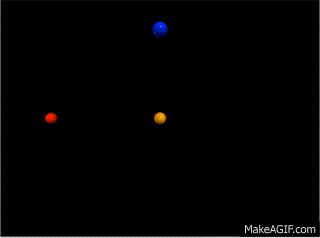Collisions
SECOND EDIT BY SUNGJAE HYUN IN 2016-04-16 ADDITIONS MADE BY (currently in progress, adding computational model and difficult problem) Sam Webster 4-17-16
This topic covers Collisions, a comprehensive way to combine the Momentum and Energy Principles.
The Main Idea
Collisions are special types of contact interactions between objects. From a physics standpoint, collisions are a way to combine the Momentum and Energy Principles. In the case of collisions, if we choose a system of the two objects interacting, the change in momentum of the system and the change in energy of the system are both zero. With this in mind, calculations with collisions become very simple. There are two types of collisions, Elastic Collisions and Inelastic Collisions.
A Mathematical Model
What are the mathematical equations that allow us to model this topic. For example [math]\displaystyle{ {\frac{d\vec{p}}{dt}}_{system} = \vec{F}_{net} }[/math] where p is the momentum of the system and F is the net force from the surroundings.
A Computational Model
The following situation was used for this model created using python:
Two objects are initially moving towards a third stationary object. Object 1 (in red) at position (-10,0,-2)m has a mass of 2kg and velocity (10,0,2)m/s. Object 2 (in blue) at position (0,6,3)m has a mass of 4kg and velocity (0,-6,3)m/s. Object 3 (in orange) at the origin has a mass of 5kg. The objects collide at the origin and after the collision it is observed that object 1 has embedded in object 3 (hence it is no longer visible in the model) and the combined object moves with velocity (5,-6,0)m/s. The final velocity of object 2 is calculated and used in the rest of the simulation. (NOTE: the white sphere visible after the collision represents the origin to add dimension to the model. Also use the link below the model for a more detailed explanation of the calculations and concepts).
Check out the code used for the simulation at [1]. The code is commented pretty heavily (but it does assume some knowledge of python and python animations) in hopes that future students can modify some of the variables to experiment with creating different results.
Examples
Be sure to show all steps in your solution and include diagrams whenever possible
Simple
Example 1) A 0.5 kg soccer ball is moving with a speed of 5 m/s directly toward to 0.7 kg basket ball which is at rest. When two balls collide and sticks together what will their final velocity be?
___
m1 = 0.5 kg v1,init = 5 m/s m2 = 0.7 kg v2,init = 0 m/s
So m1 * v1 + m2 * + v2 = (m1 + m2) * vfinal
LHS = 0.5 * 5 + 0.7 * 0 = 2.5 kg*m/s RHS = (0.5 + 0.7) * vfinal = 1.2 * vfinal
LHS = RHS in inelastic collision
2.5 = 1.2 * vfinal
vfinal = 2.5 / 1.2 = 2.08333
Thus, the final velocity is 2.08 m/s.
Middling
Example 2) A bullet of 50 caliber machine gun is 42 grams. It strikes a wooden target block of mass 10 kg stationed on a friction-less surface. The wooden block gains velocity of 1.8 m/s after being embedded with the bullet. What was the velocity of the bullet before it collided with the target?
m1 = 42/1000 = 0.042 kg v1,init = ? m2 = 10 kg v2,init = 0 m1,2 = 0.042kg + 10kg vfinal = 1.8 m/s
m1 * v1,init + m2 * v2,init = (m1 + m2) * vfinal
0.042 kg * v1,init = (0.042 + 10) * 1.8 m/s v1,init = 18.0756 / 0.042 = 430.37 m/s
Final Answer: The bullet's speed is 430.37 m/s.
Difficult
Example 3) Two rocks in space are approaching a third stationary rock. Rock 1 has mass 30kg moves with velocity (13,-10,-2)m/s. Rock 2 has mass 60kg and moves with velocity (-3,23,3)m/s. Rock 3 has mass 35kg and is stationary. The rocks collide at rock 3's location. After the collision it is observed that Rock 1 has embedded into Rock 3, but a chunk of mass 15kg has broken off of the combined rock, Rock 3'. It is also noticed that Rock 2 is now moving with velocity (-2,12,2)m/s.
First determine the momentum of Rock 3' plus the momentum of the 15kg chunk.
Later Rock 3' is observed moving with velocity (x,y,z), what is the velocity of the 15kg chunk?
With the information you know, determine the combined change in internal energy for all of the rocks.
Connectedness
- How is this topic connected to something that you are interested in?
- How is it connected to your major?
- Is there an interesting industrial application?
History
Put this idea in historical context. Give the reader the Who, What, When, Where, and Why.
See also
Are there related topics or categories in this wiki resource for the curious reader to explore? How does this topic fit into that context?
Further reading
Books, Articles or other print media on this topic
External links
Internet resources on this topic
References
This section contains the the references you used while writing this page
